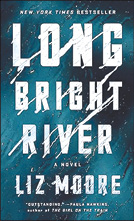
Long Bright River By Liz Moore
Who doesn’t enjoy the occasional well written whodunit? This one is a winner. The protagonist is a police officer named Michaela–Mickey, for short. Her sister is Kacey, a drug addict and prostitute. The plot bounces back and forth between the present day and a time 20 years ago, when both were teenagers or even younger. They are studies in family dynamics, when the family is almost totally dysfunctional: Mickey is bright and studious, quiet and well-behaved; Kacey is oppositional at school, and wild with her peers, in every way you can imagine. She drops out of school and walks the streets, earning drug money.
Mickey learns, at police headquarters, that a young woman has been found murdered; soon three more bodies are discovered. There is a serial killer abroad. At about this time Kacey disappears, and even though they are estranged at this point, Mickey sets out to find her sister, fearing that she has fallen victim to the murderer. She enters the dirty underworld of drug dealing, a dangerous world indeed, even for a police officer who is armed. The Fitzgerald family, relatives on the girls’ father’s side, also seem to be involved somehow. There is a rumor that a member of the police force is part of the problem, so Mickey can no longer trust her colleagues–except for one, her former partner.
Complicating the plot is the fact that Mickey has a young son who is the center of her private life, and for whom she has to provide some sort of care while she is on duty. The father of the child, another police officer who is a sleazy character, does not keep up his child support payments and ultimately disappears from the scene. The plot grows more complex by the page; action after action, crisis after crisis; danger on every hand. It makes your heart pound, but you can’t give it up. There is the girls’ dreary childhood, plus the horrid world of drug addiction, juxtaposed to the love the girls still feel for one another. There are many fearful male characters and two are strong and positive; there are also two positive female characters who emerge as the story progresses. One in particular comes to Mickey’s rescue by establishing a caring relationship with Mickey’s little boy. The other comes to Mickey’s aid near the end of the book, using her professional skills to expose the network of dark figures who populate many of the pages.
And the ending? Mixed, with two semi-positive outcomes. The reader is satisfied that Mickey comes out in decent though not enviable shape, and Kacey survives, but tentatively. The characters are well drawn, believable, realistic. It’s not a book you’d want to re-read, only because it is painful, but it’s a book you’ll be glad you did read, because we all need to know what’s going on in “that other world,” which may not be all that “other.”